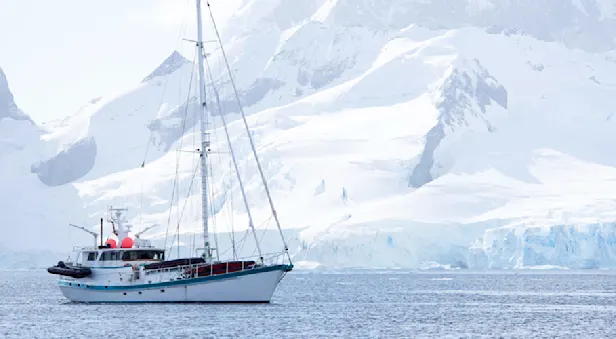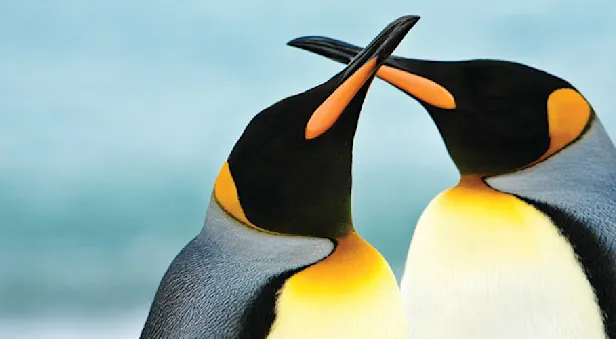Penguin Facts | Antarctica Wildlife Guide
The penguin is the quintessential image that comes to mind when picturing the frozen landscape of Antarctica. There are approximately 17 to 19 penguin species, all inhabiting the cooler regions of the southern hemisphere, with the notable exception of the Galapagos penguin, which is found just north of the equator. Only two species make their permanent homes on the continent of Antarctica: Adélies and Emperor penguins. Another three species—Chinstraps, Gentoos and Macaronis—breed at the northern tip of the Antarctic peninsula.
Penguins are flightless birds, adapted for a life spent swimming and hunting in frigid ocean waters. Species living at lower latitudes rely on cold-water currents to subsist. When not molting or raising their young, penguins live at sea. These seabirds deftly evade predators and navigate through their aquatic environment with ease. Analysis of their pectoral girdle has revealed that penguins were once able to fly but lost this ability, as their flippers evolved for a life spent in the ocean.
PHYSICAL DESCRIPTION
Penguins swim by flapping their flippers underwater, unlike most birds that paddle with their feet. The stiff flippers are adapted to propel the penguin through the ocean.
Penguins have many similarities to the great auk, a flightless bird in the northern hemisphere that was hunted to extinction in 1844. When British sailors reached the southern oceans, they named the penguins they came upon after the similar-looking great auk, whose scientific name is Pinguinus impennis.
Birds possess light, often hollow bones, as well as air sacs in the body cavity to make them as weightless as possible for flight. Penguins, on the other hand, lack air sacs and have solid bones to prevent buoyancy and allow them to dive. Their streamlined bodies allow them to quickly escape underwater predators such as leopard seals. But when the agile penguin does not move its flippers, it quickly comes to a halt in water. In order to breathe at the surface without completely stopping, penguins have developed a technique of swimming called “porpoising.” This method allows them to rapidly flap their flippers and leap out of the water in a low arch before submerging into the icy depths.
The large claws on a penguin’s powerful feet aid them in gripping ice and slick rocks. Their feathers account for 80 percent of the penguin’s insulation, while 20 percent stems from their layer of fat. Penguins maintain a high metabolic rate and an internal body temperature of approximately 101°F. Their bodies are built to withstand and even thrive in the harsh environments of the Antarctic.
BEHAVIOR
The majority of penguins can submerge for five to seven minutes and dive a maximum depth of 330 feet, but the large Emperor penguin can remain underwater for up to 18 minutes and dive up to 2,070 feet. Penguins can swim up to 15 miles per hour but may appear to be traveling faster due to their small size.
FEEDING HABITS
Penguins feed on sea creatures close to the ocean surface, near the shore or by the edge of the ice pack. Large Antarctic penguins feed primarily on squid, while smaller penguins eat large amounts of krill, along with some squid and fish. In the summertime, krill becomes the staple food source for all Antarctic penguins, which is evident from their pink feces that spot the white landscape.
BREEDING
Penguins are social animals, nesting together in colonies. Penguins in the Antarctic line their open nests with pebbles collected on the beach and other materials found at the nesting site such as bones and feathers. Small stones are also sometimes stolen from other penguins’ nests. King and Emperor penguins, the two largest species, refrain from making nests.
Because Emperor penguin chicks have a more extended phase of dependency, they hatch in the dark of winter so that they fledge in late summer. Both parents share in incubation and feeding duties, with the exception of the Emperor penguin; males of this species are the sole incubators of the egg. Colonies of Emperor penguins nest on the sea ice rather than on land. An Emperor male keeps the single egg warm in the frigid temperatures by balancing it on the tops of his feet and sheltering it with a fold of abdominal skin called a brood pouch. He must shuffle around with the egg precariously balanced for approximately 64 days, growing thinner as he fasts while the female feeds at sea. If the chick hatches before the mother’s arrival, the father can temporarily sustain the newborn with small amounts of crop milk secreted by the esophagus. When the mother returns, she regurgitates food to feed her chick. Some penguin species, including the Emperor, form crèches. These groups of chicks huddle together for protection and warmth while their parents feed at sea, with only a few adults left behind to guard the young offspring.
The breeding colonies of penguins are filled with the hustle and bustle of daily life. Eggs are typically incubated for five to six weeks, and chicks fledge at different times depending on the species. Chinstraps and Adélies fledge at 7 weeks old, while Gentoos leave the colony at 14 weeks.
See Penguins on These Antarctic Expeditions

Sailing Antarctica: A Polar Wildlife Expedition
Those with a passion for true adventure won't find a more exhilarating thrill than exploring Antarctica on an intimate voyage by private motorsailer—for just seven guests! Kayak and camp on the ice, too.


Antarctica, South Georgia & the Falklands
A comprehensive voyage to the wildlife-rich Falkland Islands and historic South Georgia, where a million-plus king penguins reign—plus the wonders of the Antarctic Peninsula!
























